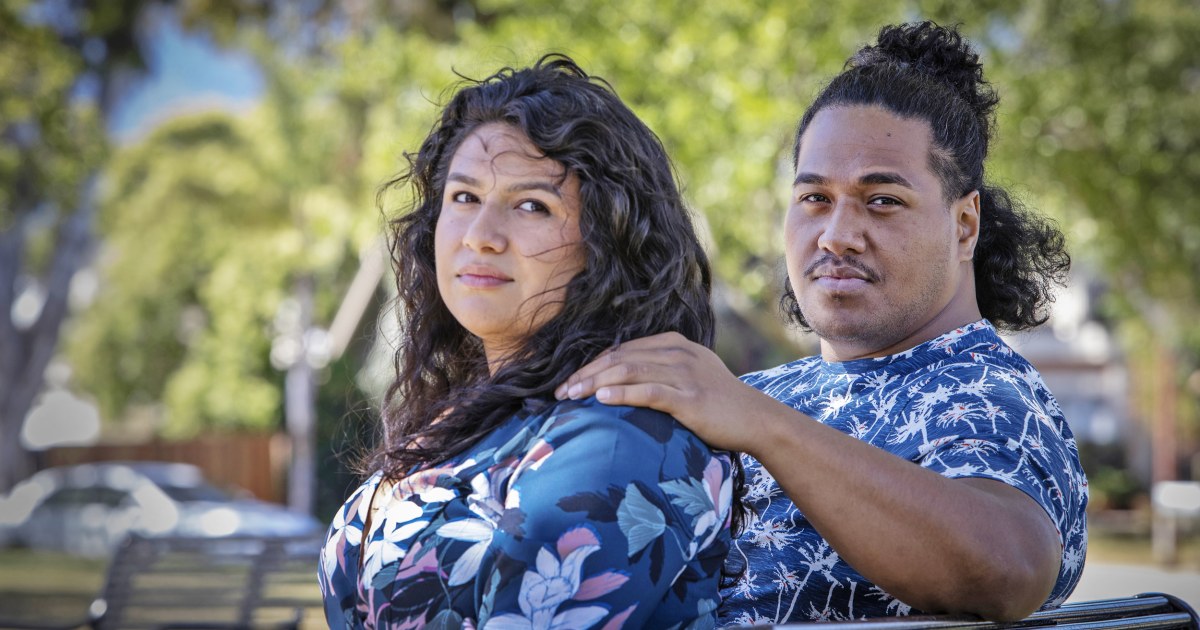
This investigation was published in partnership with The Marshall Project, a nonprofit news organization covering the U.S. criminal justice system. Sign up for The Marshall Project’s newsletter or follow them on Facebook or Twitter.
SAN JOSE, Calif. — Eliel Paulino was less than a block from his apartment complex late one night in 2015 when red police lights flashed in his SUV’s rearview mirror. After he pulled into his parking lot, police told him the light on his license plate was out.
Within minutes, a routine traffic stop became a beatdown, court records show. An officer yelled at Paulino to stop talking, then pulled him to the ground. A second policeman jabbed his baton into Paulino’s gut; a third struck him more than a dozen times with a baton. An emergency room doctor needed four staples to close the wounds in Paulino’s battered right arm.
In police reports, officers claimed that Paulino fought and resisted arrest; video from a security camera showed he did not. The city paid Paulino $700,000 after a jury found the beating violated his constitutional rights.
“The San Jose Police Department has a problem using excessive force,” the jury forewoman, Jessica Erickson, said in an interview. “It needs to stop.”
In the national conversation about policing over the past year, public attention has focused on those who die at the hands of officers. Americans know the names of George Floyd, Breonna Taylor, Tamir Rice and others killed by cops. Few know that tens of thousands of people like Paulino end up in emergency rooms after run-ins with police.
Data from the Centers for Disease Control and Prevention show that since 2015, more than 400,000 people have been treated in emergency rooms because of a violent interaction with police or security guards. But there’s almost no nationwide data on the nature or circumstances of their injuries.Many of the country’s roughly 18,000 law enforcement agencies don’t tally or make public the number of people who need medical care after officers break their arms, bruise their faces, or shock them with Tasers.
Researchers point out that only a tiny portion of arrests involve force. But when police do use force, more than half of the incidents ended with a suspect or civilian getting hurt, according to a 2020 analysis. It’s unclear how serious the harm is. “We need better data on injury severity,” said Matthew Hickman, a professor at Seattle University and one of the study’s authors.
Most experts agree that injuries at the hands of cops remain underreported.
“This data depends on the discretion of police, who get to decide who is worthy or unworthy of an ambulance,” said Nicole Gonzalez Van Cleve, an associate professor of sociology at Brown University who has researched the Chicago Police Department. “It is absolutely an undercount.”
But even as the rate of injuries goes unacknowledged in the national conversation about police reform, it has strained the relationship between officers and the people they aim to serve — particularly in Black and brown neighborhoods.
“There is a withering away of community trust,” said Van Cleve. “The police are not seen as enforcing the law, they are seen as outside the law.”
Only in a place like San Jose, which requires officers to report injuries and encourages them to bring wounded suspects to the hospital, do we have a glimpse of what the national scale of the issue might be. The city, with just over a million residents in the heart of Silicon Valley, took the rare step of tracking injuries and hospitalizations as part of a years-long effort to reduce violent interactions between residents and officers, after long-standing complaints that officers were beating up civilians.
Despite those efforts, about 1,300 people ended up in the emergency room after interacting with city police from 2017 to 2020, an analysis of San Jose’s data by NBC News and The Marshall Project found.
Most of the ER visits involved officers using their hands on suspects, our analysis found. “Control holds,” twisting arms or holding people down, played a role in 60 percent of the cases. Almost 20 percent of people who went to the emergency room were shot with stun guns, and 10 percent were hit with an “impact weapon” such as a baton.
In those four years, city data show, encounters with San Jose police left 72 people “seriously injured,” which includes broken bones, dog bites and internal injuries. Nine more people died, all from gunshot wounds.
Rough arrests have cost the city more than $26 million in lawsuit payouts for civil rights violations since 2010, according to the analysis by NBC News and The Marshall Project.
Chief Anthony Mata, who took over the department in March, said that when it comes to use of force, his officers are reacting to the behavior of the people they encounter.
“We try to use the minimal force,” he said. “But sometimes individuals are not compliant or are resistant.”
How typical is San Jose’s track record? Do the same analysis “on any department in the country and you would come up with the same results,” said Bob Scales, a police consultant for the city and many other law enforcement agencies. The most unusual thing about San Jose is that it makes its data public, he said.
Another unusual thing about San Jose is how often a use of force ends with a trip to the hospital: about 43 percent, which is among the highest of the nine cities we looked at that track when a run-in with police results in an emergency-room visit.
But some police departments may have a low percentage of emergency-room visits because they have loose reporting requirements and don’t make officers seek medical treatment for people who are hurt – creating the possibility of a significant undercount of the true rate of injury.
San Jose officials say their rate reflects the city’s policy of taking injuries seriously. Unlike many law enforcement agencies, the San Jose Police Department has rules telling officers to get a “medical clearance” from a hospital when someone “has been struck in the head with an elbow, a knee, or a kick.”
Officers routinely go further, current and former officials say, taking people with even minor wounds or complaints to the emergency room, in part because the local jail requires it. A spokesman for the Santa Clara County Jail did not respond to requests for comment.
“Officers are erring on the side of caution” when they take people to the hospital, said Eddie Garcia, who led the San Jose Police Department from 2016 to 2020, and is now the chief in Dallas. “That doesn’t mean that we are breaking arms and causing skull fractures.”
‘It’s situational’
The police in Denver, like San Jose, have strict rules about seeking medical attention when someone complains of injury, though the decision about whether to go to the hospital is made by EMS, not officers. Medics took people to the hospital in 38 percent of the use-of-force cases.
In Chicago, the police department’s handbook requires officers to request medical assistance if they shoot someone with a gun or a Taser, or hit them with a baton. But if there’s no weapon involved and the person doesn’t ask for medical help or have obvious wounds, there’s not a mandatory trip to the ER.
“It’s situational,” said Sgt. Rocco Alioto, a Chicago police spokesman. “He’s got an injury from that arrest, you’re going to have to get that looked at. But if he’s not complaining of an injury, and there’s no visible sign of injury, then there’s nothing that says that we have to call or take them to the hospital for clearance.”
About 34 percent of use-of-force incidents in Chicago end in a hospital visit, our analysis found. The city’s office of inspector general said it may be an undercount, pointing to a change in the way the police department tallies hospitalizations.
“We have seen gaps in use-of-force reporting,” said Deborah Witzburg, the deputy inspector general for public safety. “In an area where there is so much need for transparency and accountability, any lack of clarity is really problematic.”
In Mesa, Arizona, a city of a half-million residents near Phoenix, 36 percent of use-of-force incidents ended with a trip to the hospital between 2017 and 2020. The police department doesn’t require officers to call EMS or take a person to the ER after a rough arrest, a spokesman said.
So people with injuries that would send them to the hospital in San Jose end up in jail in Mesa. For example, surveillance video in an apartment building caught Mesa police beating Robert Johnson during a 2018 arrest, leaving him with a swollen face and injuries on his chest, back, shoulder and arms. Even with the blows to the head, officers took Johnson directly to jail.
A departmental investigation found that the officers did nothing wrong. Charges against Johnson were dropped, and he then filed a federal lawsuit against the police, which is pending. In court papers, city attorneys said the force was justified.
‘I couldn’t believe this was happening’
San Jose’s efforts to reduce police abuse go back to the days of Rodney King. After his infamous beating by Los Angeles police officers in 1991, San Jose was among the first big cities to employ an independent police auditor who investigates civilian complaints about officers.
Walter Katz took on the role in 2015, San Jose was a “baton heavy department” where cops injured people and broke bones, he said.He added that police officials weren’t conducting robust investigations of civilian complaints.
“They really had a weak use-of-force accountability system,” Katz said.
In a push for transparency, in 2017 the department hired Scales’ consulting firm, Police Strategies, which created a publicly accessible website that culls use-of-force information from police reports.
As the picture of police behavior became clearer, San Jose officials learned that their officers were using batons and rubber bullets more than other law enforcement agencies.
Department officials say they have encouraged officers to use weapons less often. In 2015, “impact weapons” were involved in 19 percent of use-of-force incidents, the Police Strategies report shows. By 2019, that had dropped to 11 percent. But officers were wrestling with suspects more often. Two-thirds of all of 2019’s use-of-force incidents led to injuries, a rate the report described as “above average.” The majority of the injured people ended up in the emergency room.
Critics seeking police reform want more than detailed statistics.
“I don’t think there’s any pats on the back or gold stars given out for chronicling their overuse of force and injuries on civilians,” said Raj Jayadev, founder of the criminal justice watchdog group Silicon Valley De-Bug. “The end of the story isn’t, ‘Here are all the people we’ve killed’ or ‘Here are all the people we’ve maimed.’ The point is to stop it.”
He and other critics complain that San Jose isn’t doing enough to root out problematic cops. Marco Cruz, the officer who tackled Paulino to the ground in 2015, for example, was transferred to the training unit to help teach recruits. The department declined to make him available for comment. Paulino’s lawyer said he moved back to his hometown in Mexico; he could not be reached for comment.
In interviews and reports, police auditors criticized the department’s internal reviews of use of force, saying investigators didn’t fully examine whether people who were injured had actually posed a threat to officers.
Marissa Santa Cruz, whose father is a deputy sheriff, was celebrating her 22nd birthday with her boyfriend, Paea Tukuafu, at a Holiday Inn in 2019. The hotel called the cops because their music was too loud. Tensions escalated as officers ordered the pair to pack up their things and go, court records and body camera video show.
Source: | This article originally belongs to Nbcnews.com









